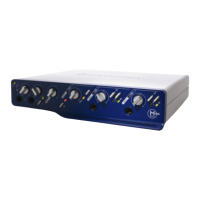
Do you have a question about the DigiDesign Mbox 2 Pro and is the answer not in the manual?
| Audio Interface | FireWire |
|---|---|
| Mic Preamps | 2 |
| Phantom Power | Yes |
| A/D Resolution | 24-bit |
| Analog Inputs | 4 |
| Digital Inputs | S/PDIF |
| Digital Outputs | S/PDIF |
| Headphone Output | 1 |
| MIDI I/O | Yes |
| Software | Pro Tools LE |
| Bit Depth | 24-bit |
Discusses safety certification and standards compliance for the equipment.
Alerts users to potential risks like electric shock and advises against opening the unit.
Lists the contents included in the Mbox 2 Pro box for the user.
Details the hardware capabilities and specifications of the Mbox 2 Pro interface.
Outlines the features and performance limits of the Pro Tools LE software.
Specifies the necessary computer hardware and software for Pro Tools LE.
Explains the process and benefits of registering the purchased Digidesign product.
Advises against using the system drive for audio, detailing performance impacts.
Lists compatible drive formats (NTFS, HFS+) and types (SCSI, FireWire).
Provides step-by-step instructions for formatting audio drives on Windows and Mac.
Explains how partitioning affects drive performance and storage management.
Discusses how drive partitioning impacts seek times and performance.
Emphasizes the importance of backing up system configurations and session data.
Addresses frequent problems like Pro Tools not launching or interface recognition.
Lists conditions affecting Pro Tools performance, like background apps and screen savers.
Provides solutions for when the audio interface is not detected by Pro Tools.
Guides users through the initial steps for installing Pro Tools LE on Windows.
Guides users through the initial steps for installing Pro Tools LE on Mac.
Outlines the general process for installing Mbox 2 Pro and Pro Tools LE on Windows.
Detailed steps for connecting hardware and installing software on Windows.
Instructions for installing QuickTime, a requirement for specific Pro Tools features.
Steps for authorizing and launching Pro Tools LE for the first time on Windows.
Provides instructions for installing Pro Tools LE on Mac OS X systems.
Explains how to physically connect the Mbox 2 Pro to a Mac computer.
Guides on authorizing and starting Pro Tools LE on a Mac.
Details the correct order for powering Pro Tools components on and off.
Explains how to adjust playback engine settings for optimal performance.
Describes how to configure the hardware buffer size for latency and processing.
Explains how to allocate processors for RTAS plug-in tasks.
Details how to set the CPU usage limit for Pro Tools processing.
Explains how to adjust the DAE playback buffer for disk operations.
Covers settings like sample rate and clock source for audio hardware.
How to set the default sample rate for new Pro Tools sessions.
Explains how to select the clock source for system synchronization.
Identifies and describes the controls and indicators on the Mbox 2 Pro's front panel.
Identifies and describes the ports and connectors on the Mbox 2 Pro's back panel.
Explains the function of the 48V phantom power switch and its indicator LED.
Provides details on phantom power requirements for microphones.
Instructions on connecting headphones for monitoring and tracking.
Guides on connecting powered monitors or home stereo systems for playback.
Explains how to connect digital devices using S/PDIF for input/output.
Describes how to connect various analog audio sources to the Mbox 2 Pro.
Details how to connect microphones, including XLR and 1/4-inch types.
Covers connecting guitars, keyboards, mixers, and DJ equipment.
Step-by-step guide to creating a session and preparing for audio recording.
Instructions on how to import audio files from a CD into Pro Tools.
Explains how to bounce audio to disk and burn it onto a CD.
Guides on setting up and recording MIDI data in Pro Tools.
Instructions for using Apple's Audio MIDI Setup utility to configure MIDI devices.
Steps to name and identify external MIDI devices within AMS.
How to enable specific MIDI channels for transmits and receives in AMS.